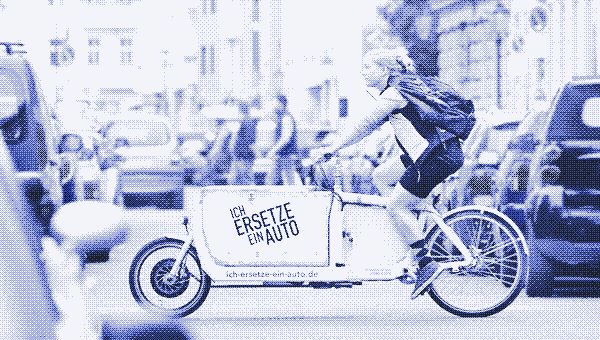
Those with strong cycling legs have ever more jobs up for grabs in Europe these days. A growing number of businesses are using cargo cycles, a move towards sustainable and free-flowing city traffic that is now strongly backed by public authorities.
Research indicates that at least one quarter of all cargo traffic in European cities could be handled by cycles. And, by using special distribution hubs, larger vehicles and electric assist, this proportion could be even larger.
A cargo cycle is at least as fast as a delivery van in the city - and much cheaper to use, giving a strong economic incentive to make the switch. Cargo cycles also bring important economic advantages to tradesmen, artisans and service providers.
As it currently stands, almost 100 percent of cargo transport in cities is done by motorised vehicles
Cargo transport in cities is extremely inefficient. As it currently stands, almost 100 percent of it is done by motorised vehicles, ranging from personal cars to commercial delivery vans and trucks (lorries).
However, these heavy vehicles often transport very light goods. The average payload transported in European cities weighs less than 100 kg (220 lbs) and has a volume of less than 1m3.1 Of the 1,900 vans and trucks that enter the city of Breda in the Netherlands each day, less than 10 percent of the cargo being delivered requires a van or truck and 40 percent of deliveries involve just one box.2
This means that a large share of the cargo being moved in and out of cities could be transported by cargo cycles. Fast, two-wheeled cargo cycles have a load capacity of up to 180 kg (396 lbs), while slower vehicles with three or four wheels can easily take 250 kg (550 lbs).
Using a tandem configuration and/or an electric power assistance can help raise the load capacity even further, to about half a ton. Cargo volume ranges from at least 0.25 m3 for bicycles to more than 1.5 m3 for larger tricycles and quadricycles.
Freight traffic takes up a large portion of total daytime road transport in cities, often as high as 50 percent in large cities, and up to 90 percent in very large cities such as London and Paris.3
The ’last mile’ is currently regarded as one of the most expensive, least efficient and most polluting sections of the entire logistics chain. This is because traffic congestion makes the driving cycle very irregular, leading to a very high fuel consumption and a loss of time.
Cargo cycles are fast, efficient, clean and quiet
The positive ecological and social consequences of substituting cargo cycles for delivery vans are obvious: important fuel savings, less pollution, less noise, more space in a more enjoyable city, less congestion, and less serious accidents.
However, this is not all. There are as many economic benefits as there are ecological and social benefits, though they are not so obvious at first sight.
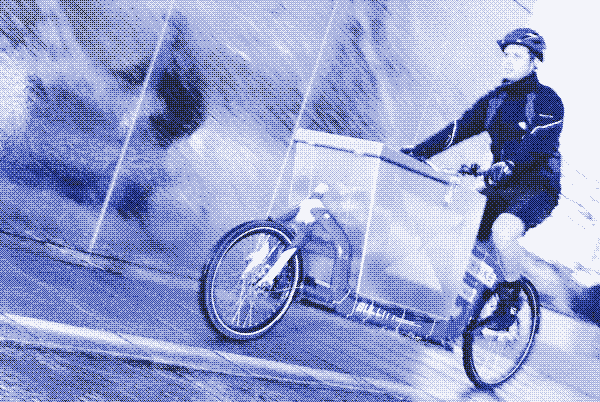
To begin with, cargo cycles operating in the city are as fast as, or even faster than, vans and trucks.4 This is because they are less affected by traffic congestion, and because they can often take faster routes where trucks and vans cannot go, such as pedestrian streets, alleys or bicycle paths.
Because cargo cycles are less affected by variable traffic conditions, journey times are more reliable. Moreover, they are able to enter the city 24 hours a day, while many Europeans cities have set very strict time windows for loading and unloading of trucks and vans. Cargo cycles have generally no difficulty finding a place to load or unload and can often stop right in front of the door or even enter a building.
98 percent cheaper
Secondly, cargo cycles are much cheaper than vans. The purchase price of an average cargo cycle does not exceed 3,000 euro, and the largest three- and four-wheeled cargo cycles with electric assist sell for about 7,000 to 10,000 euro. Buying a van sets you back at least 20,000 euro. However, for either mode of transport this cost is small compared with the running and staff costs.
The real advantage of the cargo cycle lies in its low cost of use. A car, van or truck consumes fuel, a cargo cycle does not. Moreover, taxes, insurance, storage and depreciation are all lower for cycles than for vans, which can result in significant cost savings.5 All together, a cargo cycle can be up to 98 percent cheaper per km than the alternatives.46
Because a cargo cycle is as fast as a delivery van in city traffic, and because it can move as much cargo as the van usually does, substituting cargo cycles for delivery vans will not require additional drivers.
These savings can be achieved without the loss of jobs. Some people promote the use of cargo cycles by saying that they will bring more jobs. However, this is only half true. If cargo cycles become more successful, other jobs will disappear, notably those of van and truck drivers.
Because the cargo cycle is as fast as the delivery van in city traffic, and because it can move as much cargo as the van usually does, substituting cargo cycles for delivery vans will not require additional drivers. (On longer routes outside the city, this would be different). This is actually good news, because it means that labour costs will not rise. Indirectly, however, cargo cycles can indeed create jobs (see further).
Europe promotes cargo cycling
European authorities clearly recognize the economic and ecological potential of cargo cycles. Running from May 2011 until April 2014, the EU-funded project CycleLogistics aims to reduce energy used in urban freight transport by replacing unnecessary motorised vehicles with cargo bikes in European cities.
The project aims to expand the niche market position of cargo cycles, so that they will be viewed as a serious alternative for the transport of goods in inner cities. According to research undertaken by the project, cyclists could easily move 25 percent of all cargo in cities (considering loads up to 250 kg).12
CycleLogistics will communicate the potential of cargo cycles to different target groups such as the transport sector, municipalities, service providers, tradesmen, artisans and individuals.
In order to stimulate companies and service providers to integrate the cargo cycle into their activities, the project is lending 2,000 cargo cycles to businesses and municipal services so that they can test them out. Their use will be documented and analysed, and the findings will be published in a research paper.

CycleLogistics will motivate municipalities to create a regulatory framework and policies for cargo cycles, and they will be testing and reporting on various cargo bike models, promoting their uptake by consumers, authorities and businesses alike; UK research has found that perception is probably the biggest single factor inhibiting the use of cycle freight.5 The reluctance to use cycle freight is due more to a lack of information on the vehicles and options now available rather than due to entrenched attitudes against using cycle power.
Electric assisted cargo cycles in Germany
The German Federal Ministry for the Environment has set up a similar pilot project, named “Ich ersetze ein Auto” (“I replace a car”), which began in July 2012 and will continue for two years. Contrary to the European-wide project, it will be aimed exclusively at courier services and make use of electric assist cargo cycles. Forty vehicles will be used for two years in nine major German cities.
The cargo bikes can transport a load with a weight of 100 kg and a volume of 250 litres (0.25 m3). Because these loads can also be moved by non-assisted cargo cycles, the electric assist is aimed at further increasing delivery speeds and extending the driver’s range.
In Berlin, it was found that cargo cycles using electric assist can replace up to 85 percent of car trips made by courier services.
Preliminary research by the German Institute of Transport Research showed that cargo cycles using electrical assist can replace 85 percent of car trips made by courier services in the city.
This was demonstrated during an experiment in Berlin using an additional city hub to coordinate distribution of goods (the ‘Bentobox’). The German pilot project will result in a research paper detailing the economic potential of cargo cycles, the energy and emissions savings, and the necessary improvements in infrastructure and legislation.
As mentioned earlier, the focus of cargo transport by cycles is on the “first mile” and “last mile”. Goods are delivered by vans and trucks to a (central) distribution hub, from where they are taken to their final destination by cargo cycle (or the other way around). An alternative is to use vans (or even boats or cargo trams) as mobile hubs.
UK based cargo cycle courier Outspoken Delivery uses folding bikes in combination with trains for speedy intercity deliveries between Cambridge and London. Cargo cycles as a last mile city transport option match very well with the research into trolleytrucks for goods transport on longer distances. Of course, cargo cycles can also be complemented with fully electric light vehicles in the city, such as the Cargohopper.
Courier services
A logical target group for cargo cycles are courier services. The German and the European projects aim to introduce cargo cycles to both courier companies using motorised vehicles and courier enterprises using normal bicycles. The first group can save costs and will be able to offer a faster service when replacing delivery vans by cargo cycles, while the second group can use cargo cycles to extend their market by transporting heavier and/or bulkier loads.
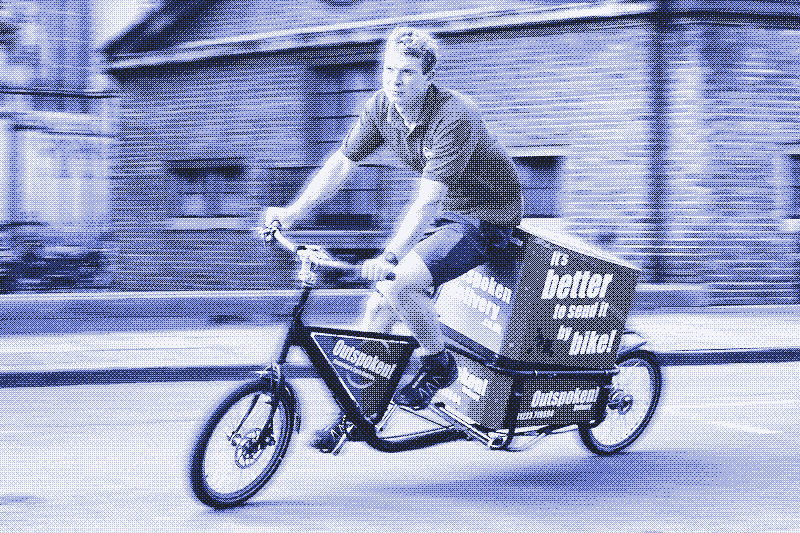
An additional incentive for traditional courier services is that they will have an easier job finding employees, because the drivers do not require a (special) driving licence. Larger fleet managers already find it hard to recruit drivers. Furthermore, the relatively low price of the cargo cycle allows courier services to build a larger and more diversified fleet of vehicles. In this way, it is always possible to choose the fastest and most compact vehicle.
Cargo cycles are already used by courier services in (for example) Brussels, Londen, New York, Berkeley, Zürich, Basel, Vienna, Graz, Rome, Reggio and San Sebastian. These are often relatively small companies, but sometimes large logistic enterprises use cargo cycles, too. DHL applies cargo cycles in 15 Dutch cities. The largest courier service to date using (electric assist) cargo cycles is the French La Petite Reine, which delivers goods in Bordeaux, Paris, Lyon and Toulouse.
The European project CycleLogistics proposes to develop and implement a next day delivery operation in conjunction with leading national and international delivery companies, in which cargo bikes are used for the final mile delivery. Cooperation with large courier services is important because regular and frequent collections and deliveries are needed to have a sustainable business model.
One of the main outputs of these experiments in several cities will be a formalised and transferable business model for running a cycle based courier business which can be adopted by couriers across towns and cities in Europe.
The cargo cycle allows service providers to start a business with a much lower investment, and to operate it at considerably lower costs.
Other companies also discover the advantages of cargo cycles, often for the delivery of their goods to customers’ houses. These are often small enterprises such as suppliers of organic food, but also larger companies like retail chain FNAC who delivers products ordered online via cargo cycle in Barcelona and Madrid. IKEA puts (large) cargo cycles at the disposal of their customers in some Dutch and Danish cities.
Tradesmen & service providers
Another target group of the European cargo cycle project are commercial service suppliers, tradesmen and artisans such as window cleaners, electricians, builders, chimney sweeps, locksmiths, painters, repairmen, carpenters, gardeners, plumbers, scrap dealers, professional photographers, musicians, street and market vendors, distributors of magazines, newspapers and advertisements, and so on.
Copenhagen has carpenters and electricians using cargo cycles, and window cleaners using cargo cycles have been spotted in Austria and in England. Home bicycle repair is another example. These services, which have been operating in many large cities for some years now, often use vans. However, a mobile bicycle repair that introduces extra automobile traffic is not very logical, so individuals in Copenhagen, Cologne, Berlin and Brussels have taken the idea one step further by using the technology they promote.
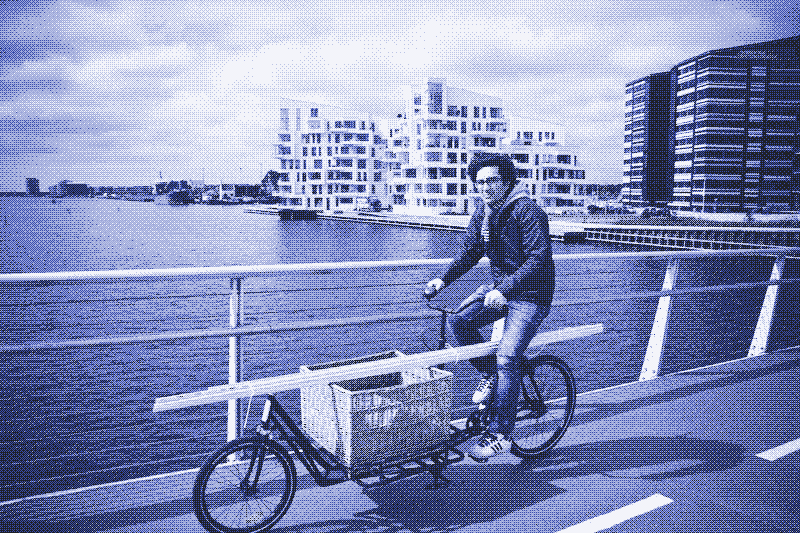
Just as the cargo cycle brings economic advantages to courier services, so it does for tradesmen, artisans and service providers. The vehicle allows them to start a business with a much lower investment, and to operate it at considerably lower costs. No motorised vehicle is required, and even a shop is not a necessity. The cargo cycle can thus indirectly bring more (self-employed) jobs.
Local authorities are another target group for cargo cycles. The vehicles could be used for maintenance of city infrastructure such as parks and roads, for repairs, senior citizens care, garbage collection or transporting official documents. This would lower the costs of municipal services, making it possible to use taxes for other aims (or even lowering them).
Learning from the past
Many proposed applications of the cargo bicycle are everything but new. 7 During the first half of the twentieth century, service providers and artisans were among the main users of cargo cycles. Almost every profession made use of cargo cycles which were specially designed to carry the tools of their trade. These were both commercially available models as well as self-adapted vehicles.
Cargo cycles also played an important role in the delivery of goods, mostly bread, meat, vegetables, fruit and dairy products. Again, every profession used a cargo cycle that was best suited to perform the specific duty. Cargo cycles were a large improvement over horse, donkey or dog powered carts, which were slower and much more expensive to operate.
During the first half of the twentieth century, tradesmen and artisans made use of cargo cycles which were specially designed to carry the tools of their trade.
Delivery of goods such as bread or meat was often done using a sturdy safety bicycle equipped with cargo platforms, boxes or baskets in different sizes fixed to the frame, mostly in the front. These vehicles, which have a payload of about 75 kg (165 lbs), are known as ‘bakery bikes’ or ‘butcher bikes’ and can still be seen on the streets of Danish and Dutch cities.
In the late 1920s an extended form of carrier bicycle appeared in Denmark, in which a load-carrying platform was inserted between the rider and the front wheel, which now being entirely separate from the handlebars, was steered by a tie-rod passing under the platform.
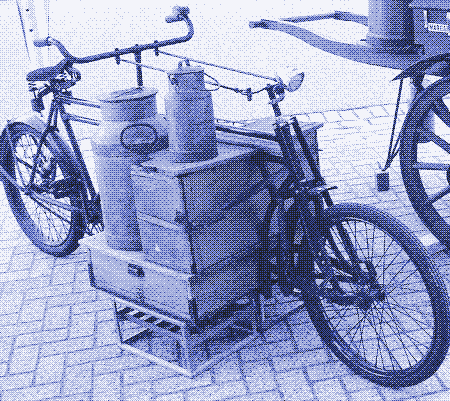
This platform was low down for stability and ease of loading. These bikes, which earned the nick-name ‘long-john’ and have payloads up to 180 kg, were (and are again) used for speedy deliveries of somewhat heavier and bulkier goods. Three-wheeled cargo bikes, still known as a ‘bakfiets’ and able to carry even heavier loads at the expense of speed, where most often used by craftsmen providing services in different locations.
Private use of cargo cycles
A final target group of cargo cycles are private individuals. People who regularly ride bikes in cities, often still have a car in case something larger or heavier has to be transported, whether this concerns shopping, moving stuff or leisure activities.
The cargo cycle is a much cheaper option which is just as effective. However, individual ownership of cargo cycles is impeded by limited parking space in dense, urban centres. Moreover, for people who can’t afford a car, buying a cargo cycle might still be too high an investment.
But all this can be solved. The LastenRad Kollektiv in Vienna, Austria, rents out cargo cycles to individuals who want to transport something big or heavy and prefer not to use a car. People pay a voluntary fee, which is used to maintain the bikes. Velogistics, a project that was inspired by it, tries to do the same at a European scale, by building an online database of people owing a cargo cycle and willing to lend it.
Will cargo cycles work everywhere?
The potential of the cargo cycle remains unclear. Presently, research is very scarce. This is remarkable, since no other technology seems to offer so many benefits for urban freight transportation. Yet, the possibilities of cargo cycles will depend on several factors, which might make them less suited in other places.
All cities where cargo cycles have taken off to some degree, are flat. Having to pedal a cargo cycle up a hill will raise delivery times considerably, which means loss of time compared to motorised options. Electric assist can help, but there might be better options for city cargo transport in hilly or mountainous regions, such as gravity-powered cable cars and aerial ropeways.
Secondly, cargo cycles are especially useful in European cities with their large historical centres consisting of narrow, winding streets. In North-American cities the average speed of motor traffic in cities is generally higher because of much wider roads, and the speed advantage of cargo cycles may disappear.
Population density also influences the usefulness of cargo cycles, which again plays into the hands of European cities. A third observation is that cities where cargo cycles are again in use already had a relatively strong bicycle culture and a decent cycle infrastructure prior to their arrival. If there is no (safe) space for cargo cycles, they cannot be used.
Reactions
To make a comment, please send an e-mail to solar (at) lowtechmagazine (dot) com. Your e-mail address is not used for other purposes, and will be deleted after the comment is published. If you don’t want your real name to be published, sign the e-mail with the name you want to appear.
Reactions
Mark Van den Borre
Mostly normal bicycles. I guess it has to do with a lack of cycling infrastructure and funding difficulties.
They seem to get used very intensely though.
And on top of that, one sees a lot of rickshaw style bicycle taxis in and around the very center though…
Economically speaking, only minimal investment Riga could make Riga the perfect cycling city. As flat as a pancake, relatively dense, very wide lanes, not much of a parking problem yet.
Attitude wise, convincing the economically stressed locals that owning a car is not necessarily progress would be the hard part. Showing them the Scandinavian examples as something to aspire to might help, especially when contrasted with something easily painted as the Russian/Slavic laissez-faire car jungle.
Kris De Decker
Randy, I think you have to make some more changes to the website in that case. It says that CycleLogistics will put 2,000 cargo cycles on European streets. I have reproduced the information I found on your website and now you tell me it is wrong.
Could I ask you how many cycles are available to businesses and municipalities? And what the number of 2,000 cycles is based upon?
Doug Haynes
This is not just happening in Europe; here in Chicago there is a company, Chicago Cargo, using a Bullet Harry Vs. Larry cargo bike to do delivery routes and recently a window cleaning and graffiti removal company has started using the same bike in their business.
isaac
When I was living in Salt Lake City, Utah, there was a Jimmy Johns (restaurant, sub sandwiches) that used bikes for making deliveries and also a courier service using bikes. The Jimmy Johns was located right in the heart of down town (flat), but the courier was located outside of downtown not far from where the terrain got really steep (I’d guess 6 blocks (3/4 mile) from a hill that Prii can not climb)…. so even with hills it should still be doable.
Steve
There were no tricycle cargo delivery vehicles pictured. We have been making pedal trucks and cargo trikes for a few years, but we are always open to input as to how best to make the cargo beds.
Jonathan
Hmmm, not really sure that incredibly sustainable technology such as a cycle should be described as low tech. In many ways cycles are much higher tech than internal combustion engines. After all any idiot can burn oil and get some of the energy out, it takes a bit of creativity and care to get the so much out of a human as a source of energy…
KMarx
I look forward to the time when women will carry cargo on top of their heads. That would be real progress.
Paul - The Kind Cleaner
I run a green cleaning business in Australia using a cargo bike.
Jacob
It’s amazing how advanced China is when it comes to these kinds of technologies.
The ‘cargo bike’ or sanlunche (three-wheeled cart) as it’s known in China never left. Indeed, some poor migrants have no other possessions, and sleep in the bed of their sanlunche. They transport bottled water, seafood, collect recyclables, transport building materials, and even give rides in these pedal-powered bikes. They can be upgraded to electric versions or LPG versions through cannibalization of e-bikes or motor-scooters.
Additionally, most tradesmen use a hybrid electric bike with a steel rungs on the back and a low, study footrest to travel to and fro. On one occasion I even saw a janitor whose bicycle frame incorporated the broom handle - simply slide out to use.
here’s one: http://cargocycling.org/wp-content/uploads/2009/09/furnituretrike.jpg
Matt
All over Asia cargo cycles are still in use.There are many roads in rural areas which are only passable by light vehicles. Even whole market stalls are mounted on a cycle. Interesting is that the side car configuration is popular for cargo as well as passengers. While in Europe i never seen a cargo tricycle in side car configuration and motorcycles with a side car are only for enthusiast and not for transport or taxi duties.
On the high tech side we see that electric motorcycles are competitive with I.C.E powered ones. considering that a two stroke motorcycle pollutes the air like ten cars it will be a huge benefit replacing them with electric powered cycles. And the electric powered cargo bike will be the first affordable electric delivery vehicle.
Ben
Good article however you managed to use a copywrighted photo without asking or crediting, then you forgot to write Cardiff in your list of cities with Couriers using cargo bikes. Please could you at least credit the photo http://krisdedecker.typepad.com/.a/6a00e0099229e88833017ee3b3d119970d-pi with “Big Blue Bike, Cardiff”
Thanks,
Ben Allen - MD Big Blue Bike
Prof.Prodromal
I had to build my own utility bicycle because no one made one that fit all my needs.
http://commutercycling.blogspot.com/2012/04/construction.html
Dr Randy Rzewnicki
Cycling is good for the economy / Europe’s Wonderful World Of Bike-Based Deliveries
Check out this http://www.eltis.org/index.php?ID1=5&id=60&news_id=3788
Carol
In my country Argentina are similar bikes that use the ice cream, people selling ice cream and walk around town on bicycles very similar. For me the bike is a very good means of transportation and healthy, even good to advertise for a company or product.
David Anderson
I think that cargo bikes are great. But so are bicycle trailers. I have been using my self-designed and built bicycle trailers for our theatre company for many years. http://www.clayandpapertheatre.org/index.php/main-content/diy-bicycle-trailer.html With the top on its about a fifth of a cubic metre. It’s box measures 61x45x76cm, and, with the top removed, you can carry your best friend dressed in a tophat and trumpet to announce your presence to the world. With the top on, it will easily take 48 bottles of wine. And, best of all, when not needed you can park your trailer in a minute and cycle free as a bird.